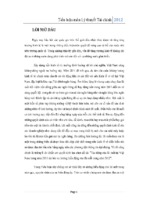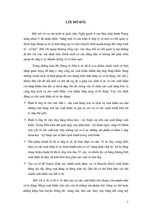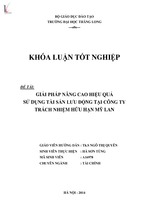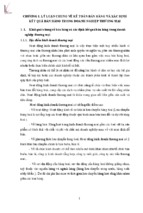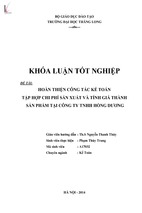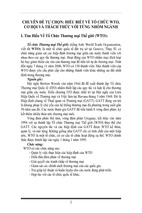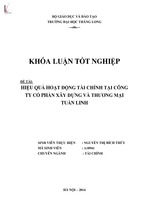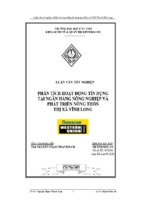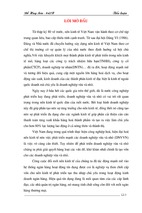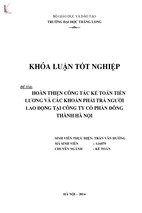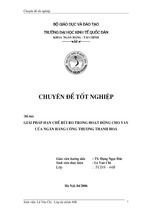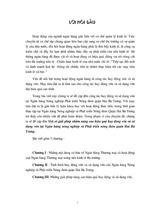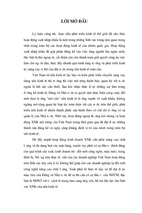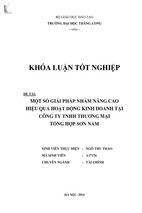FOREIGN TRADE UNIVERSITY
FACULTY OF BANKING AND FINANCE
GRADUATION THESIS
Major: Banking and International Finance
BUILDING A MODEL OF DEBT SECURITIZATION
IN VIETNAM COMMERCIAL BANKS
Student’s Full Name :
Student ID :
Intake :
Supervisor :
Do Minh Duc
1112340060
50 – A17 – CLC
Mai Thu Hien, PhD.
Hanoi, May 2015
TABLE OF CONTENTS
INTRODUCTION........................................................................................................1
CHAPTER I: GENERAL THEORETICAL REVIEW ON DEBT
SECURITIZATION..............................................................................................11
1.1. Basics of debt securitization.......................................................................11
1.1.1. Key concepts.........................................................................................11
1.1.2. Characteristics......................................................................................13
1.1.3. Relevant Members................................................................................15
1.1.4. Conditions necessary for securitization of debts...................................18
1.1.5. Benefits and risks..................................................................................19
1.2. Debt securitization in commercial banks..................................................24
1.2.1. Overview of debt securitization in commercial banks...........................24
1.2.2. Contents of debt securitization..............................................................25
1.2.3. Some methods of securitized debt outstanding......................................33
1.3. Experience of some countries in debt securitization................................36
1.3.1. The U.S.................................................................................................36
1.3.2. Malaysia...............................................................................................39
1.3.3. Lessons for Vietnam..............................................................................40
CHAPTER II: MODEL OF OUTSTANDING DEBT SECURITIZATION OF
VIETNAM COMMERCIAL BANKS..................................................................41
2.1. General context of Vietnam banking system............................................41
2.2. Status of debts in Vietnam commercial banks..........................................45
2.2.1. Causes of debts.....................................................................................45
2.2.2. Situations of handling the bad debts in Vietnam commercial banks......47
2.3. Building a model of debt securitization in Vietnam.................................50
2.3.1. Contents of the model...........................................................................50
2.3.2. Steps in the model.................................................................................51
2.3.3. Evaluation of debt securitization model in Vietnam..............................56
2.4. Conditions to apply model of debt securitization in Vietnam.................61
2.4.2. The development of Vietnam's financial market....................................62
2.4.3. Legal environment................................................................................65
2.4.4. Supply and demand for the debt securitization.....................................66
2.4.5. Competitive capacity and business structure of banks..........................68
2.4.6. Support from the State bank and government.......................................68
2.4.7. Support from the financial institutions in the world..............................69
3.1. Orientation to handle debts in commercial banking system...................69
3.2. Solutions to bring the securitization model into practice in Vietnam
commercial banks..............................................................................................72
3.2.1. Actively adapting to international common practice............................72
3.2.2. Banks' cooperation banks in the building of customer’s information
systems............................................................................................................ 73
3.2.3. Financial market solutions...................................................................74
3.2.4. Special intermediate scale extension....................................................78
3.2.5. Encourage credit institution to participate in the credit enhancement..79
3.2.6. Investment expansion together with credit quality improvement...........80
3.2.7. Improvement the quality of bank staffs..................................................80
3.2.8. Modernize banking operations..............................................................82
3.3. Recommendations......................................................................................82
3.3.1. Recommendations for strengthening the commercial banking system...82
3.3.2. Recommendations with the state bank and the relevant authorities......84
CONCLUSION......................................................................................................88
REFERENCES......................................................................................................90
LIST OF ABBRIVIATIONS
MBS
CMO
CDO
CLO
CBO
SPV
ABS
AMC
VAMC
GSEs
CIC
ROA
ROE
SOCBs
CI
Mortgage-backed Securities
Collateralized Mortgage Obligation
Collateralized Debt Obligation
Collateralized Loan Obligation
Collateralized Bond Obligation
Special Purpose Vehicle
Asset-backed Securities
Asset Management Company
Vietnam Asset Management Company
Government Sponsored Enterprises
Credit Information Center of State Bank
Return on Asset
Return on Equity
State-owned Commercial Banks
Credit Institution
LIST OF FIGURES, TABLES AND GRAPHS
LIST OF FIGURES
Figure 1.1: Illustrating the goal of securitization.......................................................11
Figure 1.2: Simple securitization model...................................................................15
Figure 1.3: Classifying stock.....................................................................................26
Figure 1.4: Collection and distribution of cash flow................................................32
Figure 1.5: Securitization of debt outstanding under the distributed method..........34
Figure 1.6: Securitization of debt outstanding under the concentrated method.............35
Figure 2.1: Simple AMC Model.................................................................................51
LIST OF TABLES
Table 1.1. Balance Sheet of the XYZ Bank ..............................................................20
Table 1.2. Balance sheet of XYZ Bank after mortgage loan ......................................20
Table 1.3. Balance Sheet of XYZ Bank ...................................................................21
Table 1.4: Stock structures of Bleecker Structured Asset Funding Ltd....................28
Table 2.1. Total outstanding debts in 7 commercial banks in Vietnam (2008-2014).....43
Table 2.2. Bad debt rates (2008-2014) .....................................................................44
Table 2.3. The Structure of issued securities ............................................................54
Table 2.4. Example of issuance of bonds..................................................................55
Table 2.5. Credit risk reserve rates (2008-2014) ......................................................56
Table 2.6. Vietcombank credit risk reserve and profit before tax in 2014................57
LIST OF GRAPHS
Graph 2.1. Total outstanding debts in 7 commercial banks in Vietnam (2008-2014)....44
Graph 2.2. Bad debt rates (2008-2014)....................................................................45
Graph 2.3. Credit risk reserve rates (2008-2014).....................................................56
Graph 2.4. Credit risk reserve/Bad debts in banks in 2014......................................57
Graph 2.5. AMCs’ capital structure in 2014.............................................................59
Graph 2.6. Vietnam’s GDP Growth (2008-2014).....................................................61
Graph 2.7. Bad debts ratio in Vietnam’s banking system in 2014 ..........................66
1
INTRODUCTION
THE NECESSITY
For more than half a century, in many countries around the world, the
banking system has really become the most important industry in national economy.
The change of the banking system always reflects the growth or recession of the
economy.
Through nearly 15 years of innovation and activities, Vietnam's banking
system has made significant achievements that contribute to the construction and
economic development of the country. However, the operation under the new
methods, banking system increasingly exposed many weaknesses, shortcomings and
inadequacies. Due to many different causes so now the Vietnam commercial banks
holding large amounts of outstanding debt (about 200,000 billion VND) exceeds the
equity of the bank. This situation makes the economy freezes, a large amount of
material to be un-exploited, the bank will become more difficult to raise new capital
and operational efficiency will rapidly decline. According to international
experience through many crises, with a heavy dependence on bank credit - reflected
the drawbacks of this market. Especially the financial crisis since 1997, it shows
that: There are many overdue loans if not addressed quickly and basically will cause
negative effects for the banking system and unavoidable risk of disruption to the
Vietnam economy. Therefore, it requires a long-term and stable funding source, and
the transmission channel for efficient capital between markets - increasingly a
demand for the development of savings funds, pension funds as well as fund
mobilization tool with the most flexibility and efficiency, such as debt securitization
instruments…
Starting from the point of view of the Party and the State, under the direction
of the Governor of the State Bank of the banking system restructuring program, the
Vietnam commercial banks has been trying to solve the problem of debts deposition
to create a healthy financial activities. Currently, the solutions of the commercial
banks are conducted in the deletion of outstanding debts with huge cost but a low
effective. If without measures to promote, then the objectives of banking
restructuring is difficult to become a reality.
2
Clearly seen this, in the process of understanding the system of Vietnam
Commercial Banks and research experience of world financial market, I see there is
a very effective financial instrument in handling outstanding debts, that is debt
securitization. With a desire to comment on the process of restructuring and
cleaning the financial activities of the commercial banking system through
securitization activities, they would like to present their perspectives on the
conditions and operational models of securitization in Vietnam.
In that sense, the thesis question: "Building a model of debt securitization in
restructuring process of commercial banks in Vietnam", to bring a new technology
(for our country) but being developed in the developed economies in the world, to
promote financial market development and solve the problems of bad debts
effectively, under conditions of international economic integration, this process will
impact not only the immediate but the long-term strategy for our country's financial
market and other the type of market in relationships between financial markets customers - economy. At the same time, meet the needs of capital for not only
economic development, but also the financial markets and real estate markets.
In the process of completing graduation thesis, because with limited
qualifications, experience, time and documents the thesis has many limitations, I
would like to receive your comments about my thesis.
3
LITERATURE REVIEW
Supply and demand of mortgages loans
In the world, research indicates that Loutskina and Strahan (2007) focused
on how the supply of mortgages loans is affected by securitization and mortgages
misconduct. The securitization has experienced the fastest grow in the mortgages
market and a large part is caused by the secondary market activities of GSEs
(government sponsored enterprises). It is regulated that GSEs only supply
mortgages below a certain threshold. Securitization is pooling the cash flows of
similar assets together and then selling this pool to a special purpose vehicle (a
separate legal entity). This pooling process lead to a diversified portfolio and these
cash flows are used to support payments on debt securities that the special purpose
vehicle issue.
Traditionally banks needed liquid deposits to originate illiquid loans.
Securitization had changed the role of banks. Instead of originate and hold the loans
banks originate and distribute the loans. Securitization advances financial
integration and investor diversification. Integration is the possibility to let capital
flow between markets. A disadvantage of integration is that the drop in the real
estate market in the U.S. and the U.K. to spread throughout the financial system.
Diversification increases the risk taking behavior because investors did not do a
proper credit evaluation. (Loutskina and Strahan, 2007)
In Vietnam, Diep Anh Vu (2010) argues that securitization activity is
essential for real estate market in Vietnam. Because, from the view point of Diep
Anh Vu, the activities of commercial banks in Vietnam currently contain higher risk
of disruption, with the warning signs of bad loans overdue being huge. There is a
total doubtful loan overdue of the commercial banking system at 31/12/2010
estimating to reach approximately 30,000 billion VND, accounting for 15% of total
loan expansion of the economy. This shows that demand for the securitization of
mortgage loans or the supply for securitized products are great and the prospect for
the development is very good. Moreover, securitization can also help to boost the
bank's capital cycle, enabling banks to find new sources of capital with many
advantages.
Decline in lending standards
4
Dell Arciccia et all (2008) link the recent sub-prime mortgages crisis with a
decline in lending standards associated with the growing expansion of this market.
They used the application of loan-to-income ratio as the indicator for lending
standard. The lending standard declines more in area with a large credit expansion,
increasing house prices and higher securitization rates. These conclusions are in line
with the theory based on information asymmetry and the relation between financial
instability and credit booms. Dell Arciccia et all (2008) also investigate the link
between lending standards and delinquency (misbehavior) rates in the market of the
subprime mortgages. In area where the volume and number of originated loans are
increasing the delinquency rates raised more. This relationship has a link with the
decrease in lending standard. Also a lot of competition in a certain area leads to a
decline in denial rates. They measured this with a significant increase in loan-tovalue ratios and the decline in loan denial rates.
The decline in lending standards can also be link with the characteristics of a
credit booms such as financial innovation (e.g. securitization), fast rising house
prices, changes in the structure of the market and the supply of aggregate liquidity.
In areas where credit booms are larger the decline of lending standards was more.
Although the credit booms dynamics are different in the prime and subprime
mortgages market, the subprime market behaves consistent with the theory of
intermediation where information asymmetry played an important role among
lenders. This asymmetry can be notices by the decline in standards in association
with the increasing number of applications. In the prime markets the credit history
of borrowers is public available and thus the information asymmetry is less. The
increasing house price is also mentioned to be one of the cause of the decline of
lending standard. Lenders were gambling that the housing boom will continue on
and on. And if the borrowers could not afford the house anymore they could
always liquidate the house and repay the loan. Disintermediation is also associated
with the decline in lending standards. In areas where the lenders sold larger
portions of their portfolios to third parties the lending standard declined more.
(Dell Arciccia et all, 2008).
5
Meanwhile, according to Dr. Minh Ngoc Phan (2011), the fact is that
Vietnam so far has not had a tool that can assess the credit risk of the mortgage
loan. The proposed loans in retail banking are therefore reviewed and evaluated
based primarily on internal credit policy of the bank, the level of risk of the bank
and the interest rate on the market. Even in some developing countries, they still
have the storage system, which specializes in providing credit history information
of all individual debtors, but in Vietnam, the system is also a luxury one. Therefore,
Vietnam commercial banks must develop policies and apparatus for evaluating and
storing the level of credit risk of the individual. And then, the database of credit
history of this type is purely individual, only that bank had known and can access
the database of those.
Also from this issue that Vietnam commercial banks also face the situation of
excessive debt of the debtor, as well as a cause of the current financial crisis in the
US. A significant proportion of the loans are formed on the basis of loans that rely
purely on past repayment of the loan application in other banks. The outcome is
often a wide range of personal loans at the same time in many banks exceeding the
level of need and ability to pay his debts. And it will create a habit that borrowers
continue to borrow at other banks to compensate for the loan matured in the current
bank loan until he completely lost the ability to pay debts.
Loan-to-Value ratios
Demyanyk and Van Hemert (2007) claimed that the foreclosure rates and the
delinquencies of subprime borrowers can be determined by high loan-to-value
ratios. Demyanyk and Van Hemert (2007) define a loan delinquent if the payments
on the loan are sixty days or more late, if the loan is foreclosed, real-estate-owned
or defaulted. A delinquent loan is thus in trouble. They focus on the performance of
young (first seventeen months after originations) subprime mortgages. High loanto-value borrowers seem to be a lot riskier than low loan-to-value borrowers. Over
time mortgages rates because more sensitive to the loan-to-value ratios of the
borrower. In principle there should be a subprime mark-up to cover the default risk
of the subprime borrower. The increase of the subprime mortgages market should
thus be accompanied with a increase in subprime mark-up. Eventually this seems
not to be the case, subprime mark up seems to decline over time. This situation was
6
not sustainable and the subprime mortgages market crashed in 2007. The subprime
market experiences the same scenario as a lending boom scenario like losing
standard, a fast growing market, declining risk premiums and worse loan
performance.
Besides, the research has shown that the field of Vietnam Mortgage is not
very large, owing to the fact that taking loans is still not a very common process
among the people of Vietnam who want to buy a house. Another reason behind this
is that private ownership of a piece of land is not allowed in the country of Vietnam.
The Constitution of the country and the Land Law says that the land is people's
property which is managed by the state administration. Therefore, the people
residing in Vietnam can have access to lands only through allocation or lease,
granted by the government. Even foreigners can can lease a land, but not more than
50 years.
Because this sector of Mortgage in Vietnam is not popular, the process is
primarily carried out by foreign commercial banks along with the state-owned
commercial banks. Due to the absence of land ownership rights for individuals, the
bank giving loans are to be affianced with the property rights. In Vietnam Mortgage,
the ratio of loan-to-value can be a maximum of 50%. This can be stretched to 60%,
if the applicant is in a very good financial condition. This rate is relatively lower
than that of developed countries, where it is around 80 – 90%. This is mainly due to
the fact that the risk involved in Vietnam is higher than in developed countries in
case the borrower could not pay back.
Securitization
Keys et all (2007) concluded that loans that are more easily securitized,
default more. Securitization is concerting illiquid loans into liquid securities.
Financial intermediation suggests that lenders do not screen the borrowers as much
as the borrowers used to due securitization. Keys et all (2007) investigated this by
using a dataset on securitized subprime mortgage loan. If the possibility is higher
that a portfolio will be securitized this portfolio defaults around twenty percent
more than a portfolio that is less likely securitized. Remarkable is that the portfolios
are the same in case of risk characteristics and loan terms. Securitization has thus an
adverse and negative effect on the bank’s screening of the creditworthiness of the
7
borrowers. Although securitization improves the credit markets the benefits are
limited. Securitization increase the distance between initiator and borrower and this
had a negative impact on the transparency. The improvement of the efficiency of the
market is only true if diversification of the risk outweighs the danger if the distance.
Mian and Sufi (2007) concluded that the expansion of the supply of subprime
mortgages between 2002 and 2005 is caused by the increase of securitization and
lead to an increasing mortgages default from 2005 to 2007. They also mention the
fact that the house prices were growing between 2002 and 2005.
Government Sponsored Enterprises (GSEs)
GSEs have two missions. First GSEs want to create and also guarantee MBS.
Second GSEs hold and purchase MBS and mortgages. Those both business lines are
needed to increase the homeownership for low- and moderate income households
and a good spread of mortgages funding in all urban areas. GSEs receive large
subsidies of the government and the government guarantees their debt. The federal
government thought that GSEs were too big to fail. Because of the government give
guarantee to GSEs they have an advantage on their MBS instead of other entities.
The debt obligations are issued at a interest rate between U.S. treasury and AAA
corporate debt. It is remarkable the GSEs itself have a lower credit rating. The MBS
are guaranteed by the GSE against default risk until the fall in 2008 (Jaffee &
Quigley, 2009). Nowadays the MBS are guaranteed by the U.S. government
because the government takes over Freddie Mac and Fannie Mae in September
2008. (Jaffee & Quigley, 2009b).
Besides that, this study provides new contributions to apply the debt
securitization in Vietnam.
First, the thesis has given the basic reasoning, the important content of debt
securitization techniques - as the foundation for making this application in
Vietnam’s financial markets. Also on the basis of analyzing hard lessons from the
current state of Vietnam commercial banks, as well as Vietnam’s financial markets,
the research has sentenced basis of an analysis and clarification to draw lessons and
provide critical solutions on the credit quality and risk management. Associated
with that is the need for technical applications of debt securitization, with the
theoretical and practical point of banking activities, from capital needs and level of
8
development of the market ... all these issues, reflects the problems which are both
necessary and feasible.
Second, the thesis has analyzed and fully evaluated Vietnam’s financial
markets. In particular, it shows the analysis and intensive evaluation of the results
achieved, the constraints of the existing market, such as currency markets, securities
and operations of financial institutions - It is the prerequisite for the implementation
of technical applications in debt securitization in Vietnam. While, it is important to
emphasize the advantages and difficulties when applying this technique in Vietnam,
as a basis for solving the problem in bad debts.
The results of Vietnam's financial markets over the period 2008-2013, which
is the difficult period of the macro economy and the banking system, as well as the
stock market and real estate market, commodity markets... It is in this context, the
difficulty is not small, especially the internal problems of the financial system also
appear and are in depth analysis and evaluation, along with the related causes.
We can say that the precondition for technical applications securitization in
the financial market of Vietnam is analyzed and evaluated in a comprehensive way
with the deepest overview of the components: the currency market, stock market,
financial institutions and related markets (real estate, houses...).
Third, the thesis has given the application of debt securitization model in
Vietnam. Based on this research to determine the strengths, weaknesses,
opportunities and challenges in applying securitization techniques in Vietnam. The
study has given technical application in debt securitization model in Vietnam, with
specific processes and technical issues related to solutions as well as to the
implementation of this model. Among them, the first implementation of securitized
real estate loans: housing loans. Because this implementation of credit securitization
of real estate is consistent and come from the need for financial markets in Vietnam,
almost bad debts in Vietnam commercial banks belong to these kind of debts, as
well as it allows to overcome the limitations existing in terms of capital, housing
and sustainable development of the financial market, real estate market in Vietnam.
Fourth, the practicality and the feasibility of the topic is high, associated
with favorable changes from the positive macroeconomic and Vietnam’s financial
markets today, with a new forecast being started when the economy our country is
"from the bottom up". This is generally a favorable and conducive environment.
9
Directly related to the ability to develop securitization techniques, with 2 important
advantages:
The first advantage today is the asset management company (VAMC) has
been established and operated - the operational objectives of this company and other
companies not related to securitization. However, the mode of implementation of
VAMC directly related to the sale of debt - would be very favorable prerequisites
for securitization techniques. If certain research questioned VAMC to perform the
securitization techniques on the securitized loans that are purchased and traded, the
practice of this technique has the beginning and the possibilities of application are
very high.
The second advantage is that the government has been focusing on
developing solutions for the real estate market to become more stable, along with
more sustainable development policies tied to social housing projects, creation of
funds to the market, associated with the development of funds like savings
accounts, retirement funds... these issues already have guidelines and performance
orientation. This creates very good conditions for real estate market development
and therefore the debt securitization will have a good base and a favorable
development.
10
OBJECTIVES AND SCOPE
The topics focused on achieving the following goals:
Learning the basic concepts, methods conducted in securitization in the US
financial markets.
After highlighting the status of outstanding debts in Vietnam commercial
banks, thesis has developed a simulation model of the securitization of mortgage
loans in Vietnam and on that basis, evaluating the Vietnam’s model.
The research is based on the general theory of securitization of debt,
securitization experience in the world, and the analysis of Vietnam’s financial
markets. Besides, it also provides the analytical assessment of the bad debt in
Vietnam commercial banks during the period between 2008 and 2014, which mostly
focus on 7 largest commercial banks: Vietinbank, Vietcombank, BIDV, Eximbank,
Military bank, Sacombank, SHB.
METHODOLOGY
The thesis uses the following methodology:
The method of dialectical materialism, analytical synthesis method,
comparative and statistical methods combined with systematic thinking approach to
go from theoretical basis, analyzing actual experiences of countries to put in
applications to suit the specific situation in Vietnam today.
Topical references, inheritance documents related to securitization as articles,
references,... to clarify the research.
CONTENTS
The layout of thesis consists of three parts:
CHAPTER I: General theoretical review on debt securitization
CHAPTER II: Model of debt securitization in Vietnam commercial banks
CHAPTER III: Solutions for the implementation of debt securitization model
in Vietnam commercial banks
CHAPTER I
GENERAL THEORETICAL REVIEW ON DEBT SECURITIZATION
1.1. Basics of debt securitization
1.1.1. Key concepts
The concept of securitization officially appeared in the 70s.
11
"Securitization is the release of the claims in the form of securities may be
sold in the market on the basis of a set of collateral for it" (Andreas Jobst, 2008)
The objective of securitization is transferred assets with low liquid assets into
high liquid assets.
Low liquid
High liquid
Figure 1.1: Illustrating the goal of securitization
Low
Liquidity
Higher
Liquidity
Liquidity
Issuance Of
Enhancement Securities
Securities
Transactions
A brief summary of the development process of securitization:
The formation of house mortgage securities
In 1970, the Association for federal home Mortgage-backed loans issued
securities secured by the Mortgage-backed security, abbreviated MBS firstly in US.
Even years later, the federal mortgage purchase company issued MBS. The first
stock of the government has a relatively simple structure without any special
allocation of cash flow or credit enhancement. Indeed, in this case, the credit
enhancement is not required by the securities are issued with the guarantee of the
government should have in a very high credit rating. The only risk is the risk of
paying in advance for the purchase of mortgage-house that are not subject to any
fines in case of prepayment. Consequently, when the market interest rate tends to
reduce, borrowers usually pay the loan prior to maturity and the security holders
must reinvest principal with income unintended.
The foundation of pledged Asset Backed Security
In 1983, the Boston Company issued a kind of new financial instruments are
backed by CMO. The basic difference between the MBS and CMO, CMO help to
transfer mortgage loans by the real estate from on-balance sheet into off-balance
sheet and after releasing, it is divided into different classes to meet the needs of
investors.
The foundation of Asset Backed Security
The success, experience that the investment bank got from the MBS market
has helped to market of flexible financial tool was developed. Asset Backed
Security was built with the strong support of the government as well as leading
12
investment banks, such as Solomon Brother, First Boston and Drexel Burhan
Lambert.
This type of securities was released first in April 1985 when the First Boston
issued 192 million USD of Security in leasing of computer of Sperry Corporation.
In December 1985, General Motors Acceptance .Corp has collaboration with First
Boston to issue the amount of securities of 500 million USD. Also that year, the
company has completely dominated this market when issuing securities worth 8
billion USD. Factors that make the success that it has limited prepayment risk, a
risk of loans for buying cars.
In 1987, the first securities issued on the basis of receivables of credit card
launched under the guarantee of Solomon Brother by released by Banc Gre. Like
other securities, Credit card securitization has achieved rapid growth and today it
still accounts for a large proportion, the leading as Citibank.
In the early 1990s, many banks and financial companies in the world faced
financial difficulties. They were quick to adopt the model ABS for securitization of
loans, types of bad debts, healthy the financial activities. This tool is called as CDO
(Collateralized Debt Obligation). CDO has quickly become an important financial
tool for business organizations, especially banks. And then the world financial units
were invented variations of the CDO as CLO (Collateralized Debt Obligation) and
CBO (Collateralized Bond Obligation). New tools as securitization have helped the
world financial units to have more tools extremely powerful and flexible to
participate in the world financial markets.
The study of the development of the stock market showed a lot of
classifications of securitized products such as securities based on home mortgage
loan, based on consumer loans (buying cars, to credit card receivables ...) or on a
commercial basis (financial leasing, commercial paper). . . But in the narrow
framework of the subject and to facilitate research, we will focus on research CDO
and its variations to see the enormous role of CDO for the restructuring of the
banking system in particular as well as modern financial markets in general.
1.1.2. Characteristics
As we know, any enterprise from trading, manufacturing, services to
enterprises but especially as banks are holding a lot of different types of assets.
13
However, must be asserted that not all types of assets can be securitized. Want to be
securitized assets must have the following characteristics.
Assets must be provided on cash flow
A basic element of securitized asset is brought to generate a cash flow from
the debtor. The value of each cash flow is dependent on the method of payment as
agreed between the parties, can according to the method of original payment,
annuity. . In fact, the loans with collateral are made by the borrower will stand out
to bring his asset as collateral to borrow money and then follow a certain percentage
on assets. Then follow the terms that will pay principal and interest. And the
fundamental of securitization is to always have money flowing through the middle
of the debtor, creditors, particularly intermediate and to investors. If in normal
conditions, operation goes smoothly, the securitization will operate basically as the
same. However, in the case of low market interest rates, the debtor will seek to
borrow money to pay for the banks and bank will bear the prepayment risk. It can
also be securitized receivables on credit cards because it contains a cash flow. But it
is worth noting here that the cash flow of the credit card payment will be very
unusual, difficult to predict the psychology of consumers. Receiving receivables
from the lender will depend on the needs and income levels of card users.
Legality
To ensure the transfer transaction, it is important and necessary that assets
related to securitization transactions must be legal. Legality here means the asset
must be certified legal ownership of the owner and without any dispute occurs when
sold. And especially the asset is not on the list of goods banned by the state.
Sale
The asset is mortgaged asset assets sold in the market is relatively high. The
collateral is usually houses, cars, computers. . . This feature is to ensure investors in
case the borrower goes bankrupt, there are things collateral for payments
Risk dispersal
Assets must also dispersal risk or risk being secured by a ratio of credit
support needed. For example, a consumer loans have relatively little value, if issue
securities on the loan, the risk is too great, so if the bank sets a lot of loans for
securitization, the payment of a loan will not affect or distort the results of the entire
payment of the entire portfolio. The result is the entire portfolio of assets can be
regarded as one asset can anticipate its solvency. In the case of some assets in the
14
portfolio works well, promising of higher payments to positively influence asset
portfolio loans will be analyzed in the direction of attractive of the entire portfolio.
Independent with the originator
This is an important feature increases the attractiveness of the securities
issued on that asset. The existence or profitability of assets is completely
independent of the existence of the originator, even when the originator is
bankrupt. To ensure that, the contract must be clearly established, the originator
must complete the transfer of legal title for special intermediated person (Special
Purpose Vehicle- SPV) and collateral is not used several times in other purposes.
An appealing factor for the stock is in the time of borrow, bank has the status of
credit evaluation of the borrower, and despite the transfer of documents related to
the SPV but the originator still monitor the payment of the borrower to receive a
Householders
service
charge.
Homogeneity of assets
Securitization process is performed when the originator set of different kinds
of assets into classes and then sold to the SPV. Then SPV set lists from different
Housebuilders
organizations to analysis, increasing the attractiveness of the asset and then issue
securities to the public. However principles set of assets that must be uniform.
SPV issues debt
Examples may not include
receivables
with receivables
from home
Transfer
of assets from credit card
securities
(assetCommercial
from the
mortgage
cash flow.
This feature is
backed)
to
banks loan because they have major differences on
originator to the
also very important. It requires the originator as wellinvestors
as the SPV must analysis,
issuing vehicle
calculate to produce a reasonable set of assets that is large enough.
Issuing agent
1.1.3. Relevant Members
(e.g., Special
Figure 1.2: Simple securitization model
purpose
Asset Originator
Capital market
vehicle –
(investment bank)
(Investors)
SPV)
Underlying
assets
(“Collateral”)
Assets immune
from bankruptcy of
seller
Originator retains
no legal interest in
assets
Typically
structured into
various
classes/tranches,
rated by one or
more rating
agencies
Issues
asset-backed
securities
+Senior tranches
+ Mezzanine
tranches
+ Junior tranches
15
A simple philosophy here is: Each participant must have certain benefits
proportionate to their contributions, to be able to understand the working process of
securitization then know the benefit of the participants. But the subject is limited to
the analysis of members.
We will review the simple securitization model and analyze members by
diagrams of securitization activities.
Originator
Originators as financial or non-financial businesses have assets needing
securitization. The Originators for the various purpose which securitizing assets on
the balance sheet of its assets such as accounts receivable, long-term loans, project
investment... A noticeable feature is that the Originator is not responsible for
payment after transferring the rights to receive benefits from asset to the Special
Purpose Vehicle. Therefore, special advantage when issuing the ABS (Assets
Backed Security) is whether credit rating of the organization is lower but it still
releases the high-quality securities. For example, the Originators only ranked Aab
can release these securities rated AAA. At the same time, due to assets held
independently initialized whether the Originator should initiate financial problems
or falling into bankruptcy, it still does not affect to the transfer of cash flow. This is
called as bankruptcy prevention mechanism (Bankruptcy remoteness) in the
securitization process.
In addition, the high-ranking securities help not only to reduce the cost of
capital but also allow large investors such as insurance companies, objects that are
often prohibited from investing in low liquid assets or rating, can buy these
securities.
Special Purpose Vehicle (SPV)
- Xem thêm -

